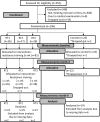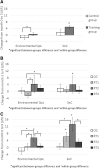Effects of a 9-month resistance training intervention on quality of life, sense of coherence, and depressive symptoms in older adults: randomized controlled trial
- PMID: 29124498
- PMCID: PMC5846971
- DOI: 10.1007/s11136-017-1733-z
Effects of a 9-month resistance training intervention on quality of life, sense of coherence, and depressive symptoms in older adults: randomized controlled trial
Abstract
Purpose: (1) To determine the effects of a 9-month resistance training intervention on quality of life, sense of coherence, and depressive symptoms in older adults, and (2) to compare effects between different training frequencies.
Methods: Men and women aged 65-75 (N = 106) were randomized to four groups according to training frequency: training groups RT1 (n = 26), RT2 (n = 27), and RT3 (n = 28) and non-training control group (n = 25). All training groups attended supervised resistance training twice a week for 3 months. For the following 6 months, they continued training with different frequencies (1, 2 or 3 times per week). Psychological functioning was measured by quality of life (WHOQOL-Bref), sense of coherence (Antonovsky's SOC-13), and depressive symptoms (Beck's Depression Inventory II). Measurements were conducted at baseline and 3 and 9 months after baseline. The effects of the intervention were analyzed using generalized estimating equations (GEE).
Results: After 3 months, there was an intervention effect on environmental quality of life (group × time p = .048). Between 3 and 9 months, environmental quality of life decreased among RT1 compared to RT2 and RT3 (group × time p = .025). Between baseline and 9 months, environmental quality of life increased in RT2 compared to all other groups (group × time p = .011). Sense of coherence increased in RT2 compared to the control group and RT3 (group × time p = .032).
Conclusion: Resistance training is beneficial for environmental quality of life and sense of coherence. Attending resistance training twice a week seems to be the most advantageous for these aspects of psychological functioning.
Keywords: Aging; Coping; Exercise; Mood; Quality of life; Well-being.
Conflict of interest statement
Conflict of interest
The authors declare that they have no conflict of interest.
Ethical approval
All procedures performed in studies involving human participants were in accordance with the ethical standards of the institutional and national research committee and with the 1964 Helsinki declaration and its later amendments or comparable ethical standards.
Informed consent
Informed consent was obtained from all individual participants included in the study.
Figures
Similar articles
-
Effects of intensive strength-power training on sense of coherence among 60-85-year-old people with hip fracture: a randomized controlled trial.Aging Clin Exp Res. 2012 Jun;24(3):295-9. doi: 10.1007/BF03325261. Aging Clin Exp Res. 2012. PMID: 23114559 Clinical Trial.
-
Associations of sense of coherence with psychological distress and quality of life in inflammatory bowel disease.World J Gastroenterol. 2015 Jun 7;21(21):6713-27. doi: 10.3748/wjg.v21.i21.6713. World J Gastroenterol. 2015. PMID: 26074710 Free PMC article.
-
Effects of exercise and horticultural intervention on the brain and mental health in older adults with depressive symptoms and memory problems: study protocol for a randomized controlled trial [UMIN000018547].Trials. 2015 Nov 4;16:499. doi: 10.1186/s13063-015-1032-3. Trials. 2015. PMID: 26537979 Free PMC article. Clinical Trial.
-
Sense of coherence--a determinant of quality of life over time in older female acute myocardial infarction survivors.J Clin Nurs. 2010 Mar;19(5-6):820-31. doi: 10.1111/j.1365-2702.2009.02858.x. Epub 2009 Sep 3. J Clin Nurs. 2010. PMID: 19732247
-
Why is Antonovsky's sense of coherence not correlated to physical health? Analysing Antonovsky's 29-item Sense of Coherence Scale (SOC-29).ScientificWorldJournal. 2005 Sep 14;5:767-76. doi: 10.1100/tsw.2005.89. ScientificWorldJournal. 2005. PMID: 16170438 Free PMC article. Review.
Cited by
-
Meaning in life: resilience beyond reserve.Alzheimers Res Ther. 2018 May 24;10(1):47. doi: 10.1186/s13195-018-0381-z. Alzheimers Res Ther. 2018. PMID: 29793549 Free PMC article.
-
Promoting healthy ageing through light volleyball intervention in Hong Kong: study protocol for a randomised controlled trial.BMC Sports Sci Med Rehabil. 2020 Jan 28;12:6. doi: 10.1186/s13102-019-0151-7. eCollection 2020. BMC Sports Sci Med Rehabil. 2020. PMID: 32002186 Free PMC article.
-
Comparing the effect of individual and group cognitive-motor training on reconstructing subjective well-being and quality of life in older males, recovered from the COVID-19.Cogn Process. 2023 Aug;24(3):361-374. doi: 10.1007/s10339-023-01136-2. Epub 2023 Apr 10. Cogn Process. 2023. PMID: 37036638 Free PMC article. Clinical Trial.
-
Molecular mechanisms of physical exercise on depression in the elderly: a systematic review.Mol Biol Rep. 2021 Apr;48(4):3853-3862. doi: 10.1007/s11033-021-06330-z. Epub 2021 Apr 17. Mol Biol Rep. 2021. PMID: 33864590
-
Feasibility of a Tai Chi with Thera-Band Training Program: A Pilot Study.Int J Environ Res Public Health. 2020 Nov 16;17(22):8462. doi: 10.3390/ijerph17228462. Int J Environ Res Public Health. 2020. PMID: 33207580 Free PMC article. Clinical Trial.
References
-
- Skevington SM, Lotfy M, O’Connell KA, WHOQOL Group The World Health Organization’s WHOQOL-BREF quality of life assessment: Psychometric properties and results of the international field trial. A report from the WHOQOL group. Quality of Life Research. 2004;13(2):299–310. doi: 10.1023/B:QURE.0000018486.91360.00. - DOI - PubMed
Publication types
MeSH terms
Grants and funding
LinkOut - more resources
Full Text Sources
Other Literature Sources
Medical



